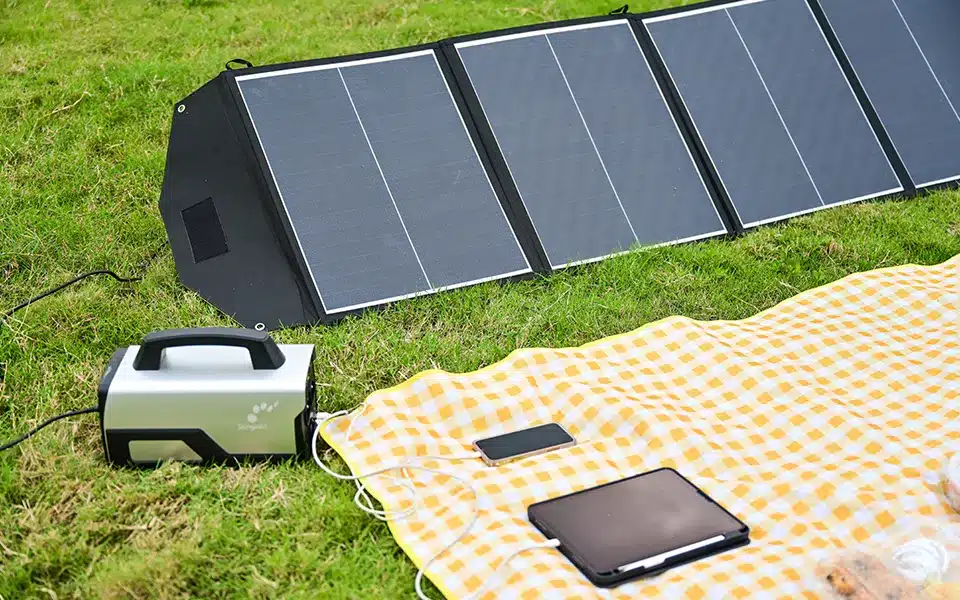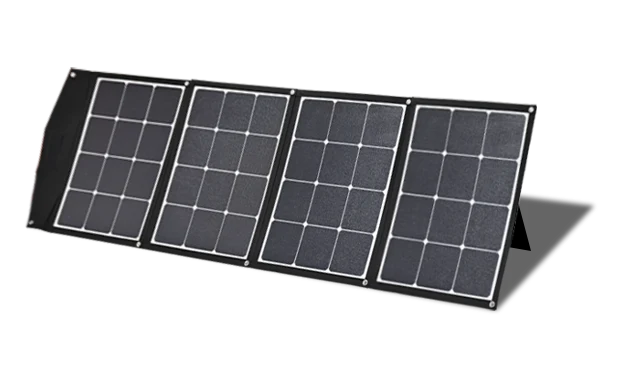What size solar panel do I need for Campers?
Choosing the size of portable solar panel for Campers depends mainly on your power needs and the power consumption of your camping equipment. Here are some steps and considerations to help you determine the size of solar panel you need:

1. Calculate your total power consumption
List all the electrical devices you plan to use while camping and estimate the daily power consumption (watt-hours, Wh) of each device. For example:
LED light bulb: 5W x 4 hours = 20Wh
Mobile phone charging: 5W x 2 hours = 10Wh
Laptop: 50W x 3 hours = 150Wh
Portable refrigerator: 60W x 10 hours = 600Wh
Total power consumption = 20Wh + 10Wh + 150Wh + 600Wh = 780Wh
2. Consider solar panel efficiency and sunlight conditions
Assume that the solar panel you choose has a high efficiency (about 20%) and you can get 5 hours of effective sunlight per day (this is a conservative estimate, depending on the location and season).
3. Calculate the required solar panel power
Divide your total power consumption by the number of effective sunlight hours per day to get the total solar panel power required:
Total power required (W) = Total power consumption (Wh) / number of effective sunlight hours (h)
Total power required = 780Wh / 5h = 156W
4. Consider batteries and charge controllers
Solar panels also need to be used with batteries and charge controllers of appropriate capacity to ensure stable power supply and store excess power. Assuming you choose a 12V battery with a capacity of 100Ah, its storage capacity is 1200Wh (100Ah x 12V).
5. Choose a portable solar panels for Campers
Based on the above calculation, you need at least a 160W solar panel to meet your daily power needs. To improve reliability and have enough power when there is insufficient sunlight, you can choose additional redundancy, such as using a 200W or higher power solar panel.
How do portable solar panels for Campers work?
A portable solar panels for Campers is a device that converts solar energy into electrical energy, helping campers get power support in the wild. Here is how solar panels work and how they are used in camping:
How Portable Solar Panels Work
Photovoltaic Effect:
Solar panels are made up of multiple solar cells, which are usually made of silicon. When sunlight shines on a solar cell, photons (particles of light) hit silicon atoms, releasing electrons. This process is called the photovoltaic effect.
Generating Direct Current:
Through the photovoltaic effect, solar panels convert solar energy into direct current (DC). Multiple solar cells are connected together to form a solar panel to increase the output voltage and current.
Charge Controller:
The DC power is transmitted to the charge controller via a cable. The role of the charge controller is to regulate the voltage and current to prevent the battery from overcharging or over-discharging, thereby protecting the battery life.
Battery Energy Storage:
The regulated DC power is stored in the battery (usually a deep cycle battery or a lithium battery). The battery stores the power for use at night or on cloudy days.

Applications in Camping Choosing the right portable solar panel:
Portable Solar panels for camping are usually portable and easy to carry and install. Choose a solar panel with the right power according to your power needs.
Installation and connection:
Choose a sunny and unobstructed place to unfold and install the solar panel. Connect the panel to the charge controller through a cable, and then to the battery.
Use power:
The charge controller monitors the battery status and uses the power stored in the battery to power the device when needed. It can directly power DC devices or power AC devices through an inverter.
Specific steps example
Unfold the solar panel:
Unfold the portable solar panel and place it in a sunny area.
Connect the charge controller:
Connect the solar panel to the charge controller using an appropriate cable.
Connect the battery:
Connect the output of the charge controller to the battery to store power.
Connect your devices:
Use the stored energy from the battery to power your devices through a charge controller or inverter.
How do we test camping solar panels?
Testing camping solar panels ensures their performance and efficiency to ensure they can meet your power needs while camping. Here are some steps and methods to test and evaluate the performance of solar panels:
1. Check the appearance and components
First, inspect the appearance of the solar panel and all components to ensure there is no physical damage or defects. This includes:
Inspect the surface of the panel for cracks or scratches.
Confirm that the connectors and cables are intact.
Make sure the charge controller and battery (if any) are in good condition.
2. Test the open circuit voltage (Voc)
The open circuit voltage is the maximum voltage that the solar panel outputs when there is no load connected. Here are the steps:
Use a digital multimeter and set it to the DC voltage (DCV) position.
Connect the positive (red) probe of the multimeter to the positive terminal of the solar panel and the negative (black) probe to the negative terminal.
Under full sunlight conditions, read and record the open circuit voltage value. This value should be close to the nominal open circuit voltage of the panel.
3. Test Short Circuit Current (Isc)
The short circuit current is the maximum current that the solar panel outputs under short circuit conditions. Here are the steps:
Set the digital multimeter to the DC current (DCA) position.
Connect the positive (red) and negative (black) probes of the multimeter to the positive and negative terminals of the solar panel, respectively, to form a short circuit.
Under full sunlight, read and record the short circuit current value. This value should be close to the nominal short circuit current of the panel.
4. Load Test
The load test can simulate actual use and check the performance of the solar panel when connected to a load. Here are the steps:
Connect a load of known power (such as a light bulb or resistor) to the solar panel.
Use a digital multimeter to measure the voltage and current across the load.
Calculate the output power (P = V x I) and compare it with the nominal power of the solar panel.
5. Charging Test
Test the ability of the solar panel to charge the battery to evaluate its actual application effect in camping. Here are the steps:
Connect the solar panel to a battery (such as a 12V battery or lithium battery) through a charge controller.
Record the initial voltage of the battery.
Allow the solar panel to charge the battery for a few hours under full sunlight.
Record the final voltage of the battery and calculate the charge.
6. Actual Use Test
Test the solar panel in an actual camping environment to observe how it performs under different conditions. Here are the steps:
Take your solar panel and related equipment to the campsite.
Observe and record the charging efficiency and time of the solar panel in actual use, including morning, midday and evening performance.
Check the battery’s storage capacity and discharge at night or on cloudy days.
The Best Solar Panels for Campers
Choosing the best solar panel for campers requires considering a variety of factors, including portability, power output, durability and ease of use. Here are some of the most recommended camping solar panels on the market, along with their features:

Sungold Portable Solar Panel SPC Series 180W
Features: High power output, suitable for camping equipment with high power demand; folding design, easy to carry and store; high-efficiency monocrystalline solar cells, improving energy conversion efficiency.
Pros: Provides sufficient power support, suitable for a variety of camping equipment; portable design, easy to carry.
Selection considerations
Portability:
Solar panels with folding design or lightweight design are more suitable for campers, easy to carry and store.
Power output:
Choose a suitable power output according to your power demand. Generally, solar panels from 90W to 180W can meet most camping needs.
Durability:
Outdoor use requires solar panels to be waterproof, dustproof, and impact-resistant to cope with various weather conditions and environments.
Ease of use:
Choose solar panels that are easy to install and use, such as those with built-in brackets, USB output ports, and other features.
Compatibility:
Make sure the solar panel is compatible with your charge controller, battery, and equipment to ensure that the system can operate efficiently.
Conclusion
When selecting portable solar panels for campers, it’s important to consider factors such as power output, portability, durability, and compatibility with your camper’s electrical system. There are a large number of solar panels on the market, and choosing the right one can be the difference between whether your equipment lasts a long time or leaves you short of electricity and money. With the information we have provided, we hope that you will be able to decide which camping solar panel is best for you. Whether you are camping in a front country campsite or camping in the wilderness off the grid, having the right solar camping equipment can make or break your experience.











